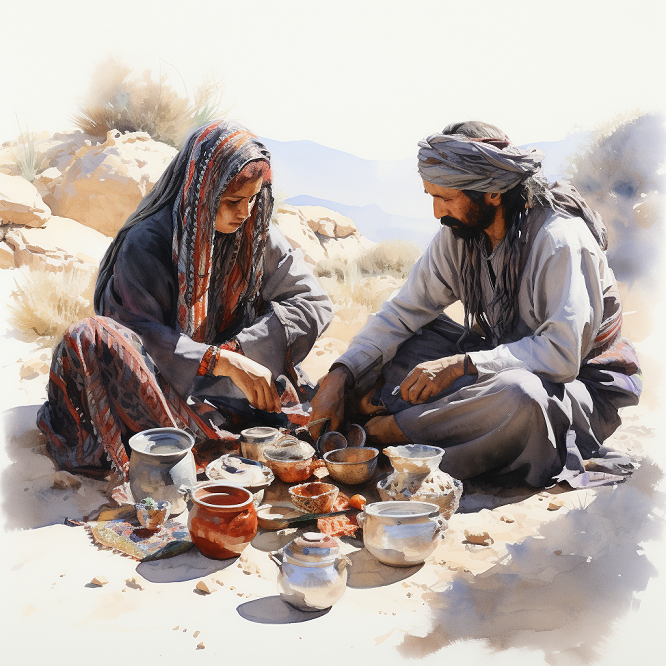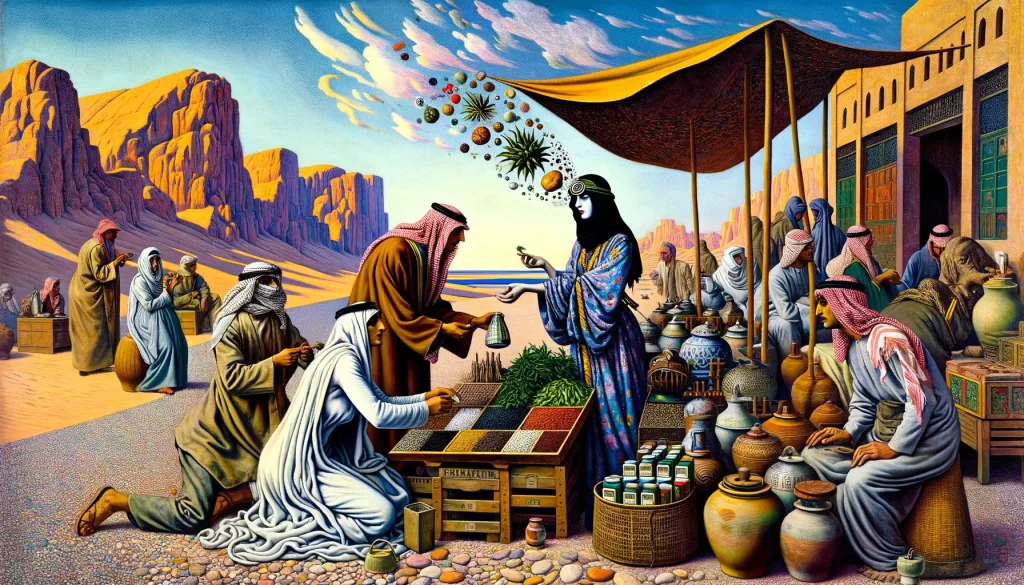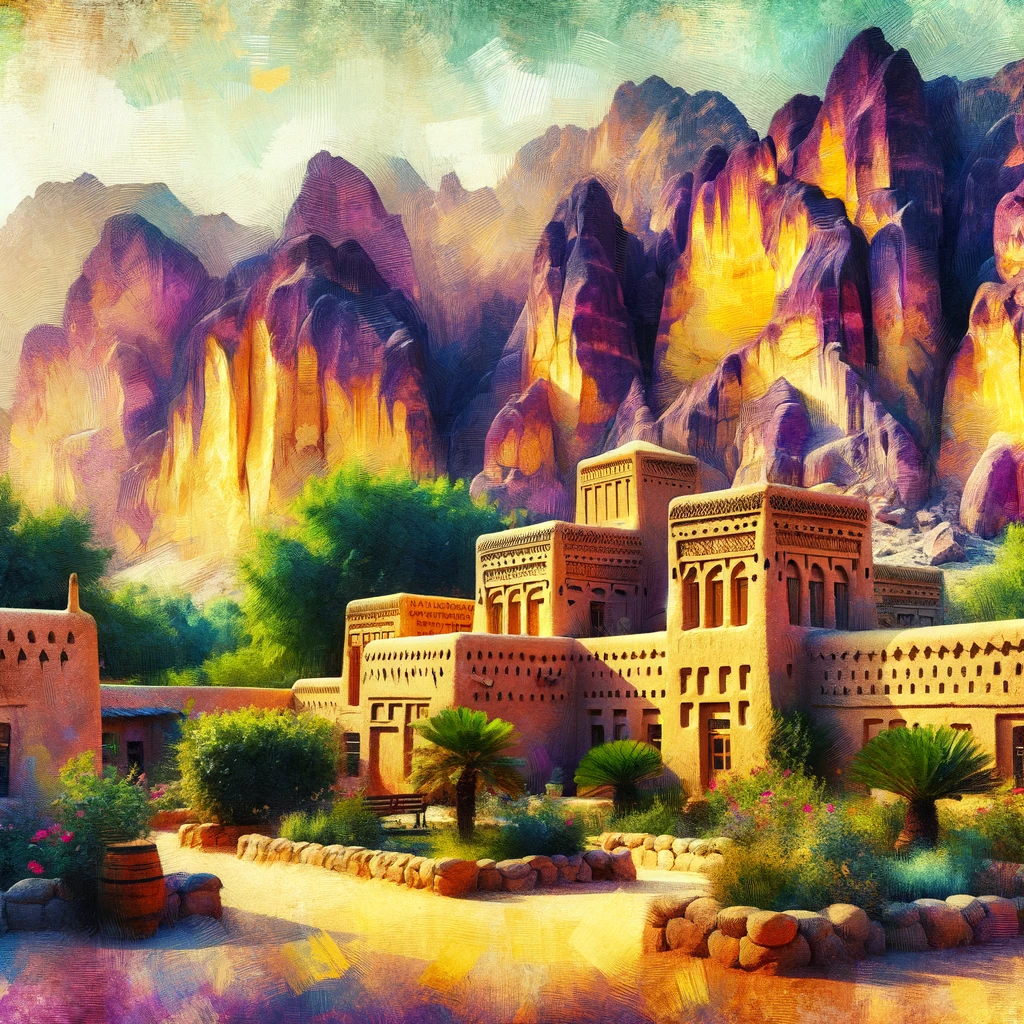Lady Anne Blunt’s books have long been celebrated for their detailed and vivid descriptions of lesser-explored regions, and her travel memoir, “Pilgrimage To Nejd,” is no exception. In this essay, we delve into a core focus of Lady Blunt’s text, particularly her exploration of the enigmatic geography and captivating lifestyle of Jubbah in Nejd.
Geography and Landscape of Jubbah
In “Pilgrimage to Nejd“, Lady Anne Blunt provides the reader with a vivid geographical description of Jubbah, an intriguing location situation in the Ha’il region of modern-day KSA. According to Arabic vernacular, the name signifies a “well” and interestingly, Jubbah can be found within a sizeable hole in the Nejd. Reflecting on her travel experiences, Lady Blunt recalls the stark contrast between the basin of Jubbah and a ‘fulj,’ a term used to describe a depression in the shape of a horse hoof.
Lady Blunt’s writing depicts the unusual geological aspects of Jubbah, referring particularly to its location. The area is conceived as a bare space enveloped by a metaphorical sea of sand. The basin of Jubbh, notably, lies about 400 to 500 feet below the average surrounding sand level. This prominent geological deviation is one of the defining attributes of Jubbah, contributing significantly to its untamed beauty and its peculiar desolate charm.
Intriguingly, Lady Blunt discusses a local belief held by the inhabitants of Jubbah concerning the origin of the basin. It was postulated that the basin at one time might have been a lake. This theory arises from the presence of conspicuous watermarks on rocks positioned above the township. These undeniable, yet inscrutable geological indicators support the locals’ hypothesis, adding a layer of mystery to Jubbah’s already captivating geography.
Through Lady Blunt’s thorough examination and articulate documentation of Jubbah’s landscape in her “Pilgrimage to Nejd,” the reader is transformed into an armchair traveller, journeying alongside her through the sands of time and untamed wilderness of Arabia’s mysterious geography.
Picturesque Settings and the Rustic Lifestyle of Jobba
In “Pilgrimage to Nejd,” Lady Anne Blunt expands her exploration beyond the geographical marvels, putting the lens onto the rustic native lifestyle and the picturesque settings of Jobba. Providing a comprehensive visual tour, she describes Jobba as a small hamlet nestled on the edge of the subbkha, a saline flat. According to Lady Blunt, the town comprised approximately 80 houses, surrounded by local palm gardens that make up the staple greenery of the arid landscape.
An integral part of this rustic landscape is the abundant wells found throughout the village. Interestingly, as Lady Blunt observed, these wells are operated in an unconventional fashion, worked by camels, which consistutes a striking example of how inhabitants adapt their lifestyle to meet the challenges posed by the natural environment.
The picturesque settings of Jobba, as narrated by Lady Blunt, extend to the charming view of the village marked by high walls and juxtaposed against the backdrop of palm gardens, ithel-trees, and dominating purple rocks. Such romanticised imageries paint the village as a realm of mystique and tranquillity, a stark antithesis to the barren arid surroundings.
The wells from which these are watered are seventy-five feet deep, and are worked, like all the wells in Arabia, by camels. The village is extremely picturesque, with its little battlemented walls and its gardens. At the entrance stand half a dozen fine old ithel-trees with gnarled trunks and feathery branches. The rocks towering above are very grand, being of purple sandstone streaked and veined with yellow, and having an upper facing of black. They are from seven hundred to eight hundred feet high, and their bases are scored with old water marks.
Pilgrimage To Nejd: Lady Anne Blunt
However, delving within the bounds of the idyllic setting, Lady Blunt reveals a stark reality. The condition of Jobba’s housing significantly reflects the economic hardships faced by the villagers due to their geographical isolation. The inhabitants’ homes are discerningly poorly maintained, an indication of impoverishment ingrained deep in the lifestyle. Despite the allure of their remarkable setting, Lady Blunt captured the paradox of Jubbah, where captivating beauty hides the residents’ struggles against impoverishment and isolation.
Thus, through Lady Blunt’s eyes, the audience gets to view Jubbah’s beautiful exterior which contrasts with the harsh reality of the villagers’ rustic lifestyle, gaining invaluable insights into the challenging existences led by the inhabitants of this isolated desert settlement. Through her writings, Lady Blunt has managed to intricately capture Jubbah’s charm and pitfalls, adding layers to the audience’s understanding of their rustic lifestyle.
Jubbah’s Regulatory System and Social Interactions
Branching out from the geographical and societal aspects, Lady Anne Blunt, in her book “Pilgrimage To Nejd”, takes the reader through the regulatory framework and social fabric of Jobba. She narrates the abrupt change in leadership when the young Sheykh Naïf ascends to power following the death of the earlier Sheykh. This transition of power, Blunt observed, was without the guidance or support of a representative from the central government, signaling a marked absence of Ibn Rashid’s lieutenant.
At the time of our passage through Jobba, the Sheykh had lately died, and his office was being held by a young man of two or three and twenty, who had no authority with his fellow-youths, a noisy, good-for-nothing set. Ibn Rashid has no special lieutenant at Jobba, and the young Sheykh Naïf was unsupported by any representative of the central government, even a policeman. The con- sequence Avas that though entertained hospitably enough by Naïf, we were considerably pestered by his friends, and made to feel not a little uncomfortable.
Pilgrimage To Nejd: Lady Anne Blunt
The lack of structured governance became only too evident as Lady Blunt traversed through the village. She was met with the sight of disorderly behaviour among the local youth, presumably a symptom of the absence of an organized regulatory mechanism that could maintain social discipline. Yet, despite these perceived shortcomings, Lady Blunt was impressed by the cleanliness in Jubbah, a characteristic which she attributed to the scrubbing effect of the surrounding desert winds rather than the efforts of the natives.
Furthermore, she noted the general absence of insects, which are commonly found in abundance in other regions. This, Lady Blunt reasoned, was attributable to the village’s geographic isolation and natural conditions rather than any active pest control efforts from the inhabitants. These observations elucidate not only the social behaviours and norms within Jubbah but also how the harsh natural environment indirectly influences the sanitary conditions of the settlement.
Thus, in “Pilgrimage to Nejd,” Lady Anne Blunt unveils the uniquely unorganized system of governance in Jubbah and how this influences social interactions within the village. Despite the challenges posed by the landscape and regulatory system (or rather the lack of it), the inherent ruggedness, cleanliness, and immediate community seem to adapt and exist in harmony with its austere surroundings. These reports, imbued with a raw authenticity, allow the readers to get a sense of the village’s unique life rhythm, marked by tangible isolation yet imbued with a striking degree of resilience.

Blood Feuds, Atrocities and Intervention
Through Lady Anne Blunt’s journey, the reader delves deeper into the gripping tale of “Pilgrimage to Nejd”, unraveling the layers of drama and tension suffused into the lifestyle of its inhabitants. The most noteworthy element being, the ambient anxiety experienced by Mohammed, Lady Blunt’s travel companion. Clearly, Mohammed’s simmering fears revolved around potentially being confronted by certain Arabs, a dread rooted in an unresolved past blood feud.
This brewing feud was eventually resolved, an outcome largely determined by the intervention of Mohammed ibn Rashid, a formidable figure and a staple in Arabian history. His intervention in resolving the feud was the stepping stone that culminated into his rise to power, a point noteworthy in the historic and social landscape of the region.
Although Jobba was an isolated village, it was not immune to instances of incivility. These instances, in Lady Blunt’s account, often appeared to be closely associated with the residents’ state of poverty and seclusion. Such events are indicative of a harsh reality that underlines the adversity faced in the otherwise picturesque settings of the village.
Furthermore, the narrative does not shy away from recounting the terrifying atrocities committed by Mohammed ibn Rashid himself during his rule. These episodes of brutality, while grim, paradoxically provided a semblance of security to the region. As oppressive as his rule might have been, it was under his reign that Jobba transitioned into a stable settlement, an irony not lost upon Lady Blunt.
In this section, Lady Blunt underscores the societal complexities of Jobba, interwoven with tales of blood feuds, ensuing violence, and the resultant outcomes shaped by intervention. Despite the breath-taking landscape, the layers of underlying tension unravel the real-life stories of the otherwise serene Jobba, providing the reader with a raw, unfiltered account of life in such an isolated settlement.
Final Stages of the Journey: Anxious Anticipation and Exhilaration
Having traversed the landscapes and delved deep into the social and political tapestry of Jobba, Lady Anne Blunt was approaching the final stages of her journey as described in “Pilgrimage To Nejd”. Her riveting narrative construction around Jobba, characterized by intimate and intricate explorations, was succeeded by a sense of anxious anticipation and exhilaration mixed with trepidation as she was about to arrive in Hai’l, another significant location in her expedition.
Lady Blunt voiced her concern and apprehension about possible confrontations with the potentially hostile locals of Hai’l. This sentiment was likely fueled by her experiences in Jobba and the unsettling remnants of the past feud encountered by her travel companion, Mohammed. Unpredictable interactions with unfamiliar and potentially antagonistic local communities are realities often faced by travelers, specifically in areas marked by complex socio-political histories. These sentiments pacing her thoughts served to highlight how her narrative did not shy away from unveiling and confronting the palpable anxiety brimming beneath the surface of their journey.
Interestingly, despite the hovering uncertainty and implicit threats, Lady Blunt’s exploration of the desert journey remained consistently marked by a sense of exhilaration and tranquil awe. This sense of serenity, sprung from her splendid interaction with the untouched terrains, was a testament to her resilience and passion as an explorer. Regardless of the concerns burgeoning within her, she never lost sight of the intrinsic beauty of the desert and the precious moments of tranquility it offered amidst the socio-political turbulence. Her unwavering appreciation for the stark calm and poetic starkness of the desert, even amidst threats and uncertainties, unfailingly found a place in her memoir, serving as an admirable testament to her spirit as an explorer.
In this stimulating phase of her journey, Lady Anne Blunt makes it abundantly clear how human experiences, illustrated in her text, need not be defined solely by safety and predictability. Her portrayal introduces a confluence of anticipation, exhilaration, trepidation and serenity, each emotion inevitably intertwined with the other, characterizing the real essence of exploration away from the comfortable enclaves of the familiar. Such a multifaceted representation, sprawled across her narrative, validates not just the authenticity of her expedition but also resonates with many an explorer’s heart, thus rendering “Pilgrimage to Nejd” as a timeless travel memoir.

Conclusion
As Lady Anne Blunt’s captivating narrative in “Pilgrimage to Nejd” draws to a close, a comprehensive depiction of the journey through the enigmatic village of Jobba unravels before the reader’s eyes. Through her detailed exploration of Jobba’s mysterious geography, picturesque settings, regulatory system, social interactions, interwoven tales of blood feuds, and the final stages of the journey, Lady Blunt offers a multifaceted view of this isolated settlement in Nejd.
Through Lady Blunt’s keen observations and vivid descriptions, the audience gains invaluable insights into the unique lifestyle, challenges, and resilience of Jobba’s inhabitants. The contrast between the captivating landscapes and the harsh realities faced by the villagers is beautifully portrayed, painting a vivid picture of the complexities and nuances of life in this secluded desert settlement.
While Jobba may be a mere dot on the vast canvas of Arabian geography, Lady Blunt’s meticulous documentation and exploration of this village breathe life into its untold stories and unseen struggles. As readers journey alongside her, they are not only transported to the physical landscapes of Jobba but also immersed in the emotional fabric and social dynamics that shape the daily lives of its residents.

